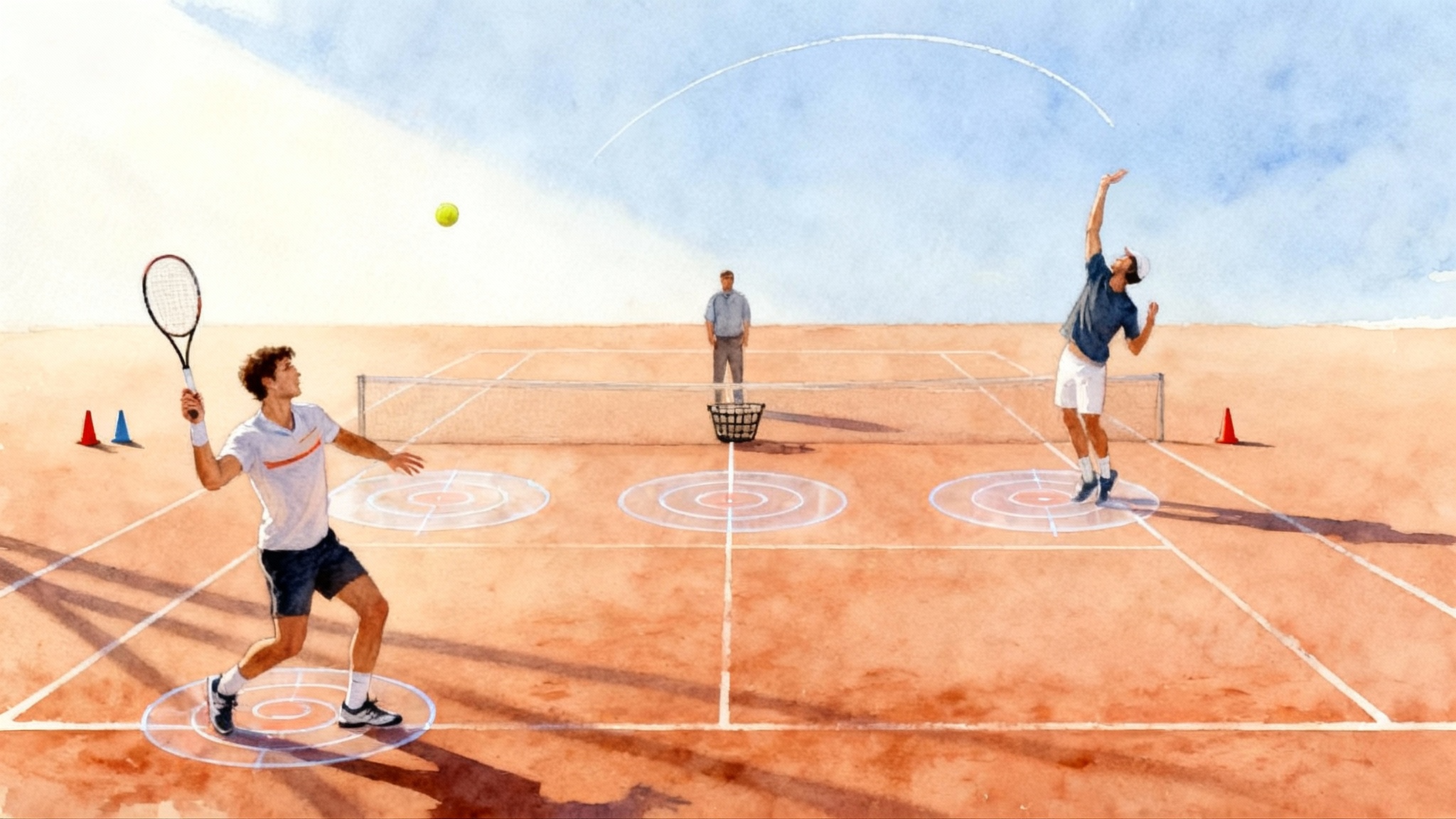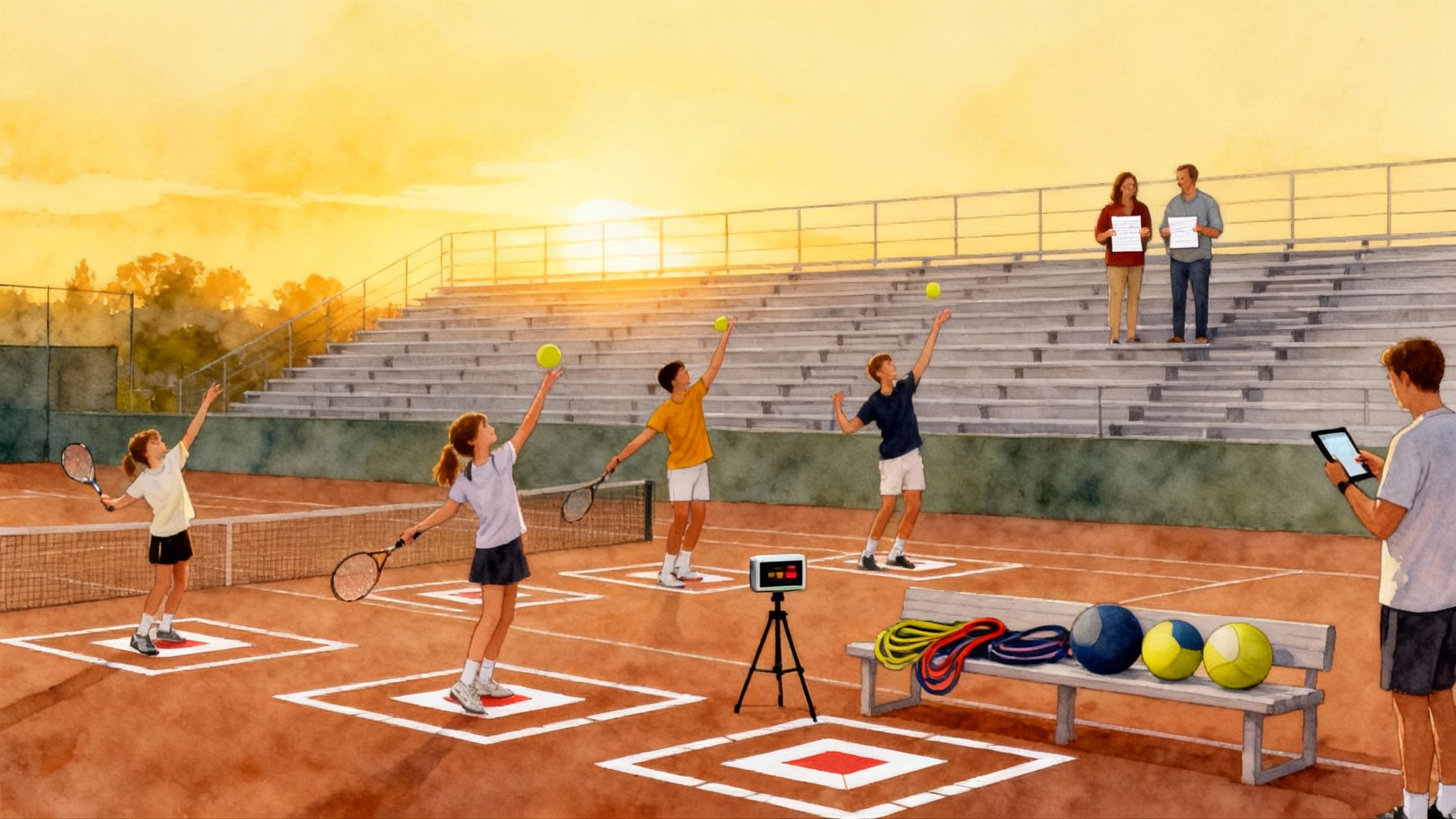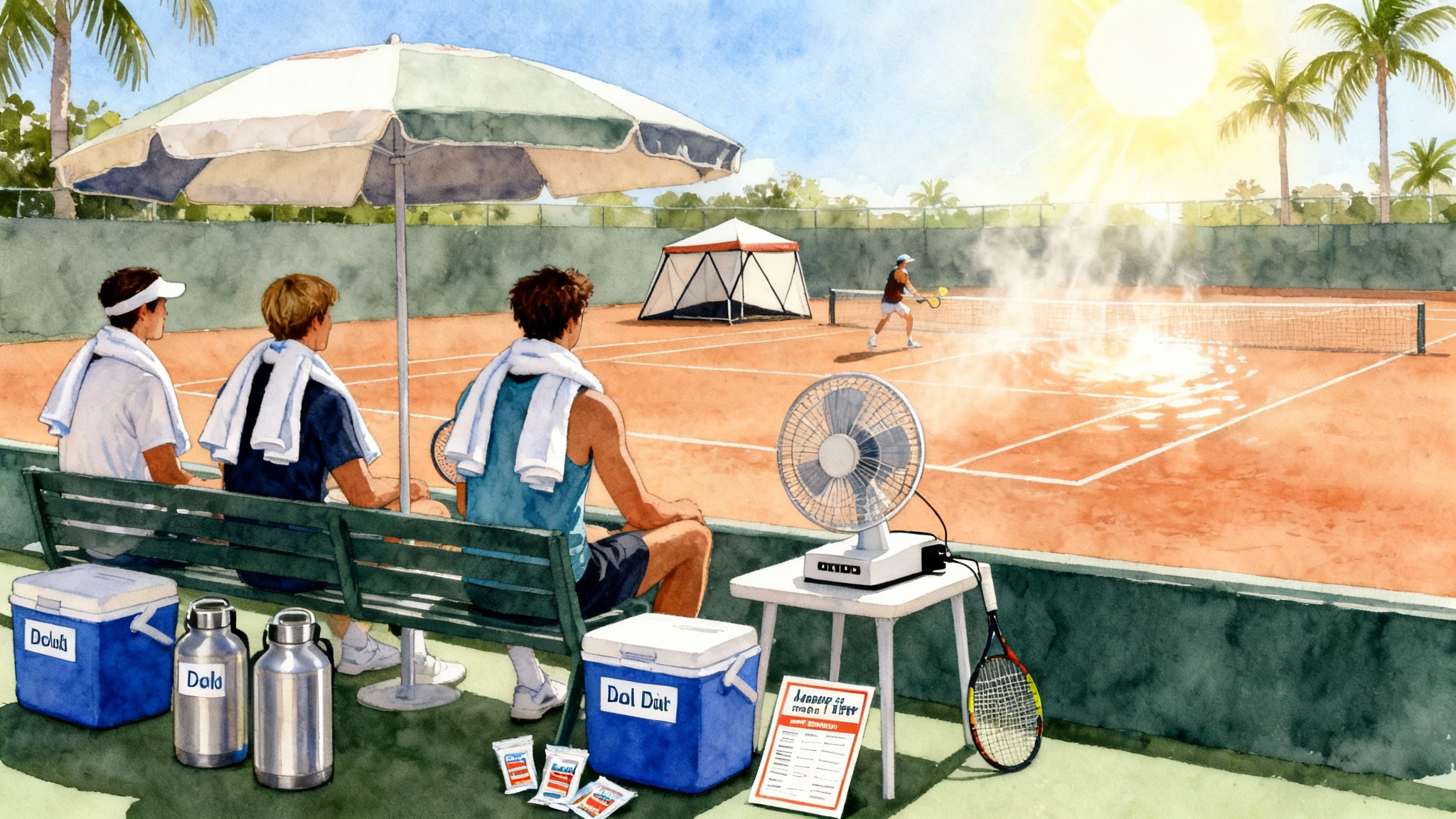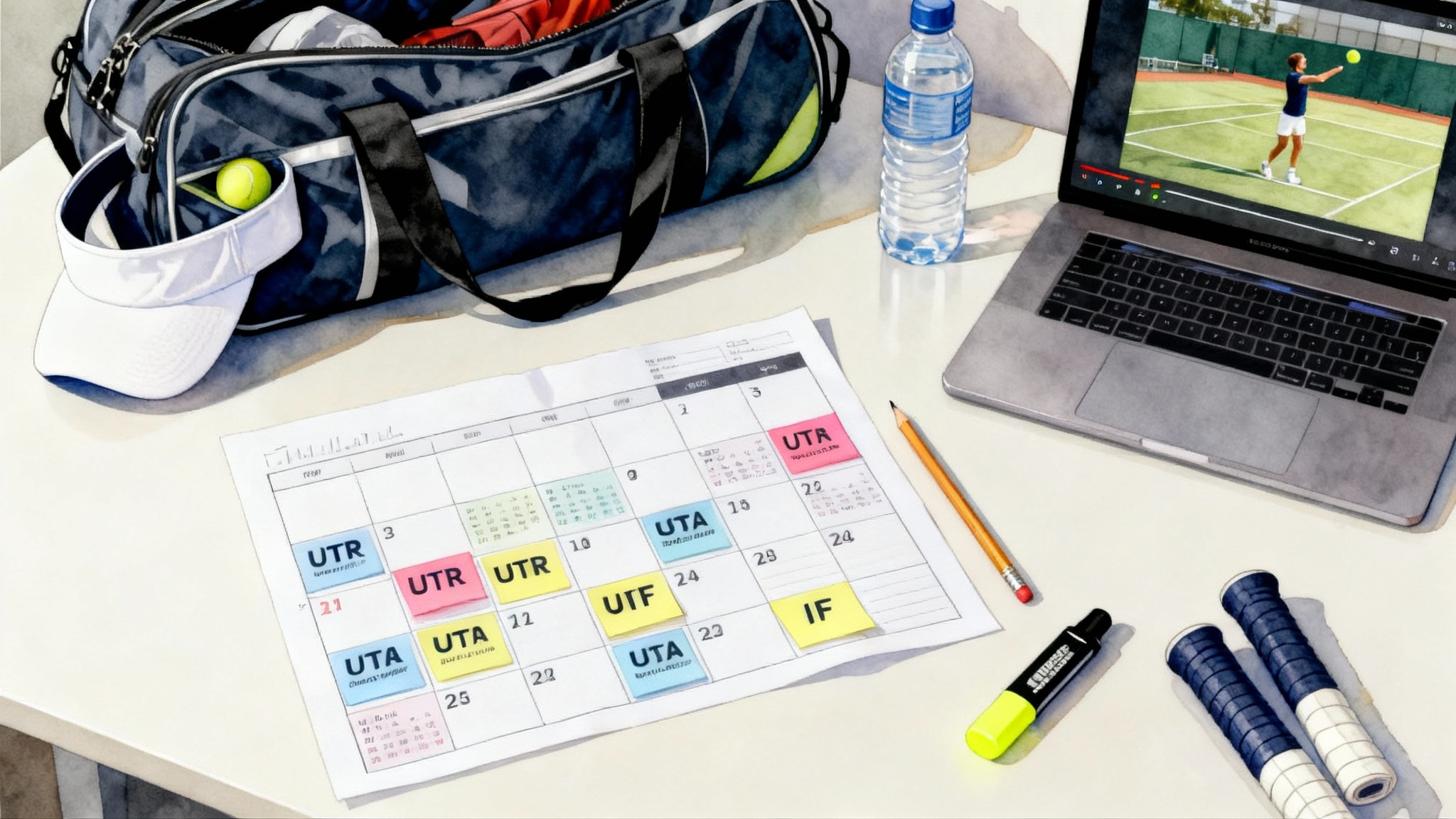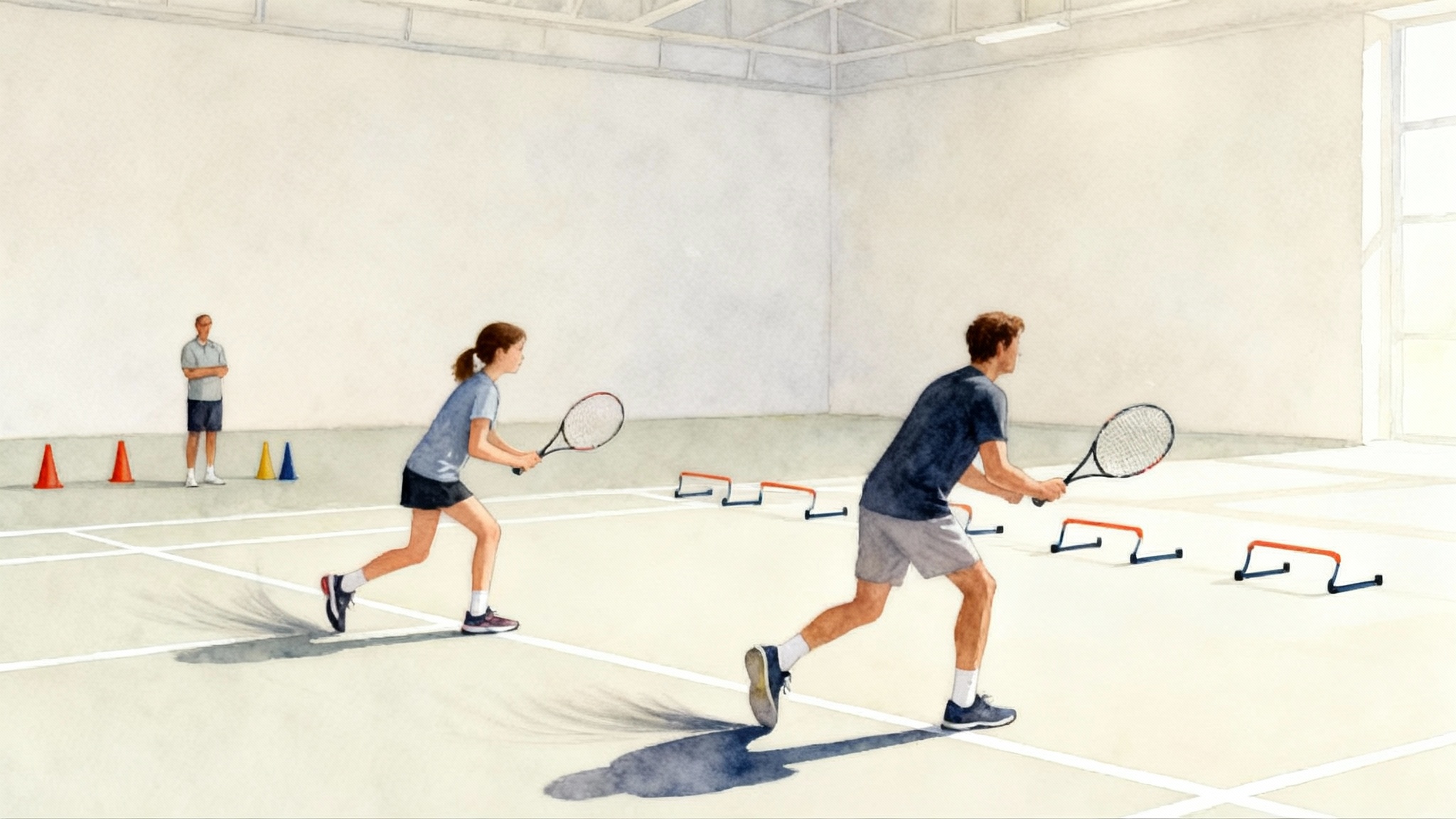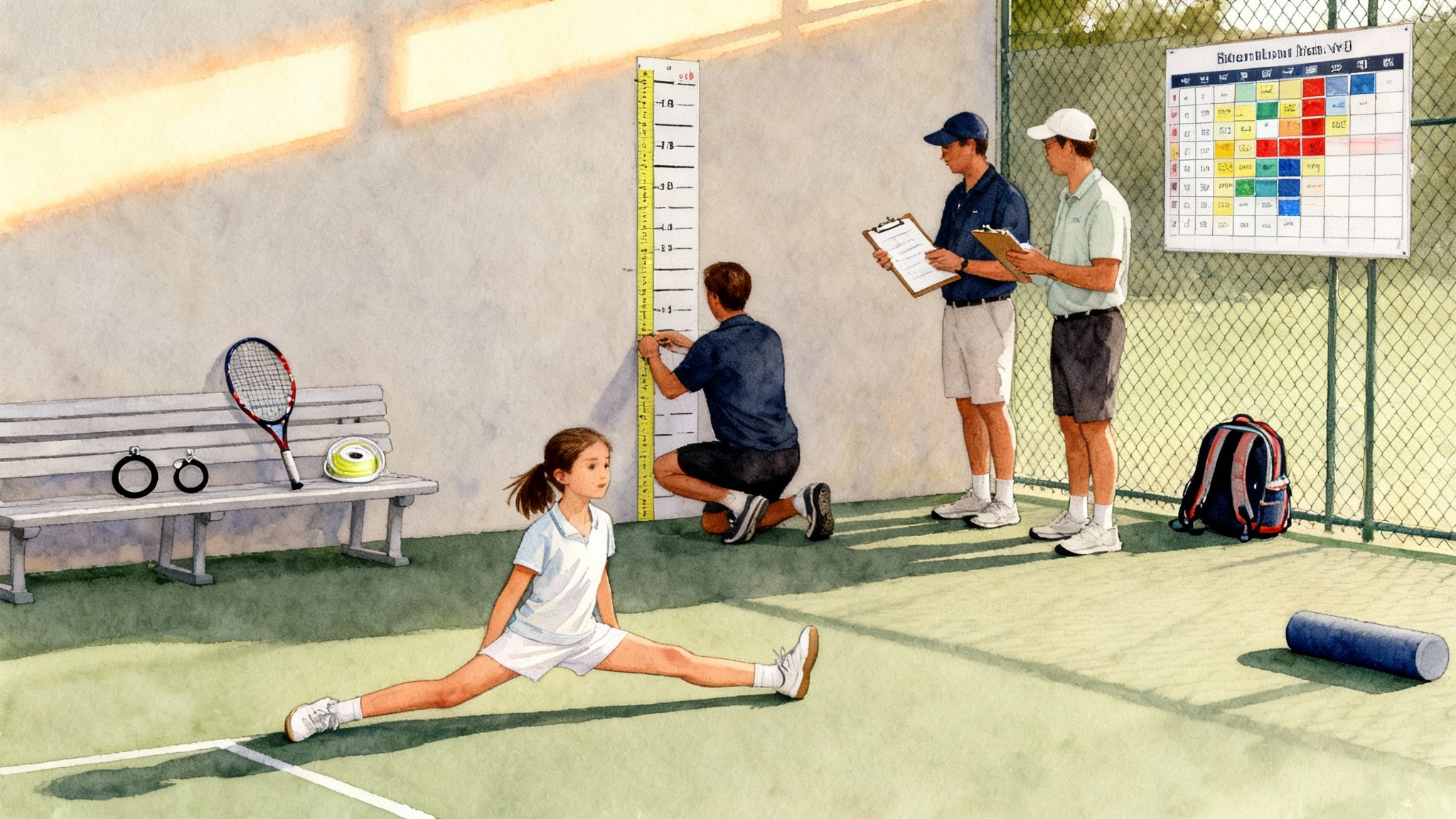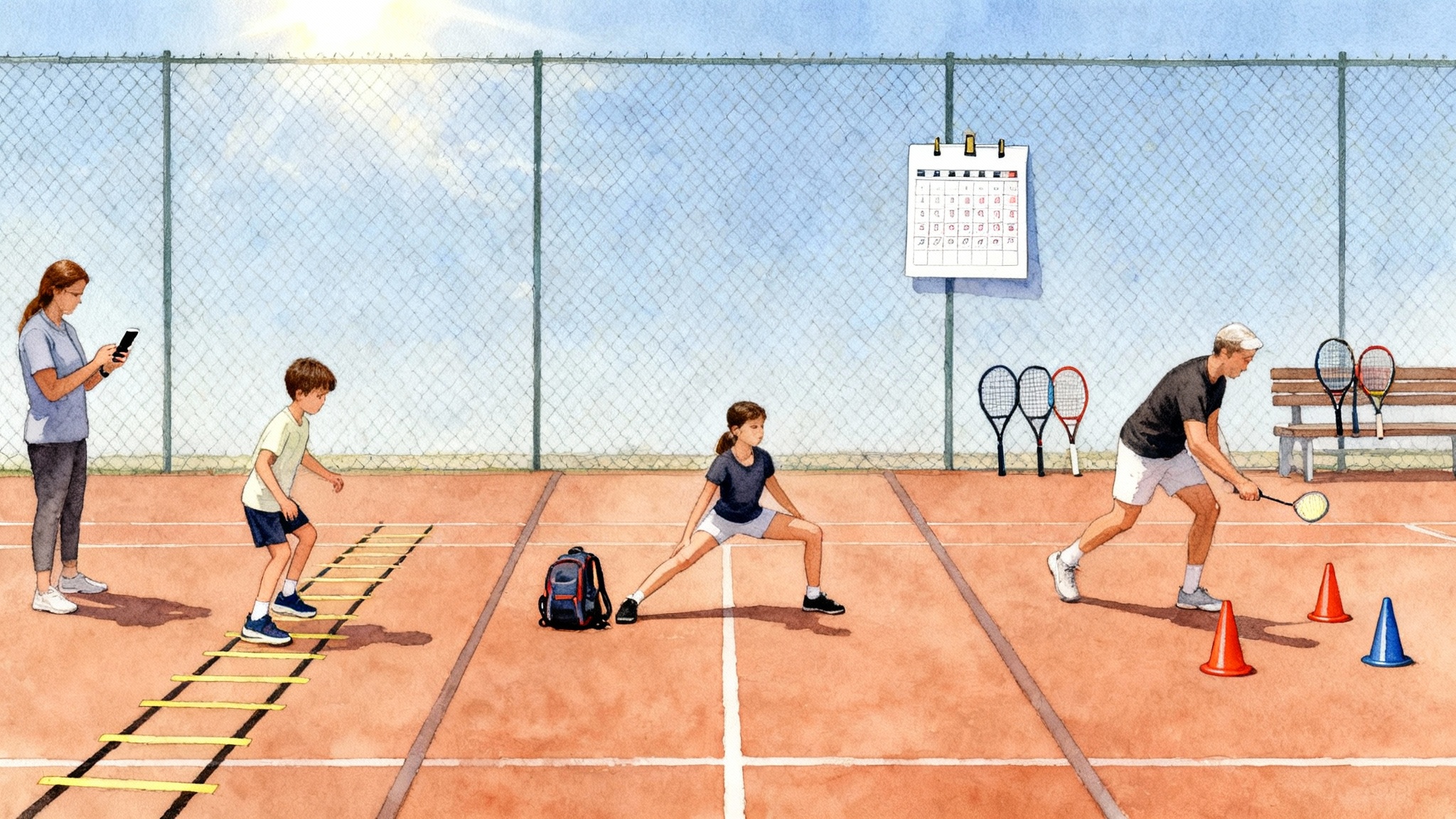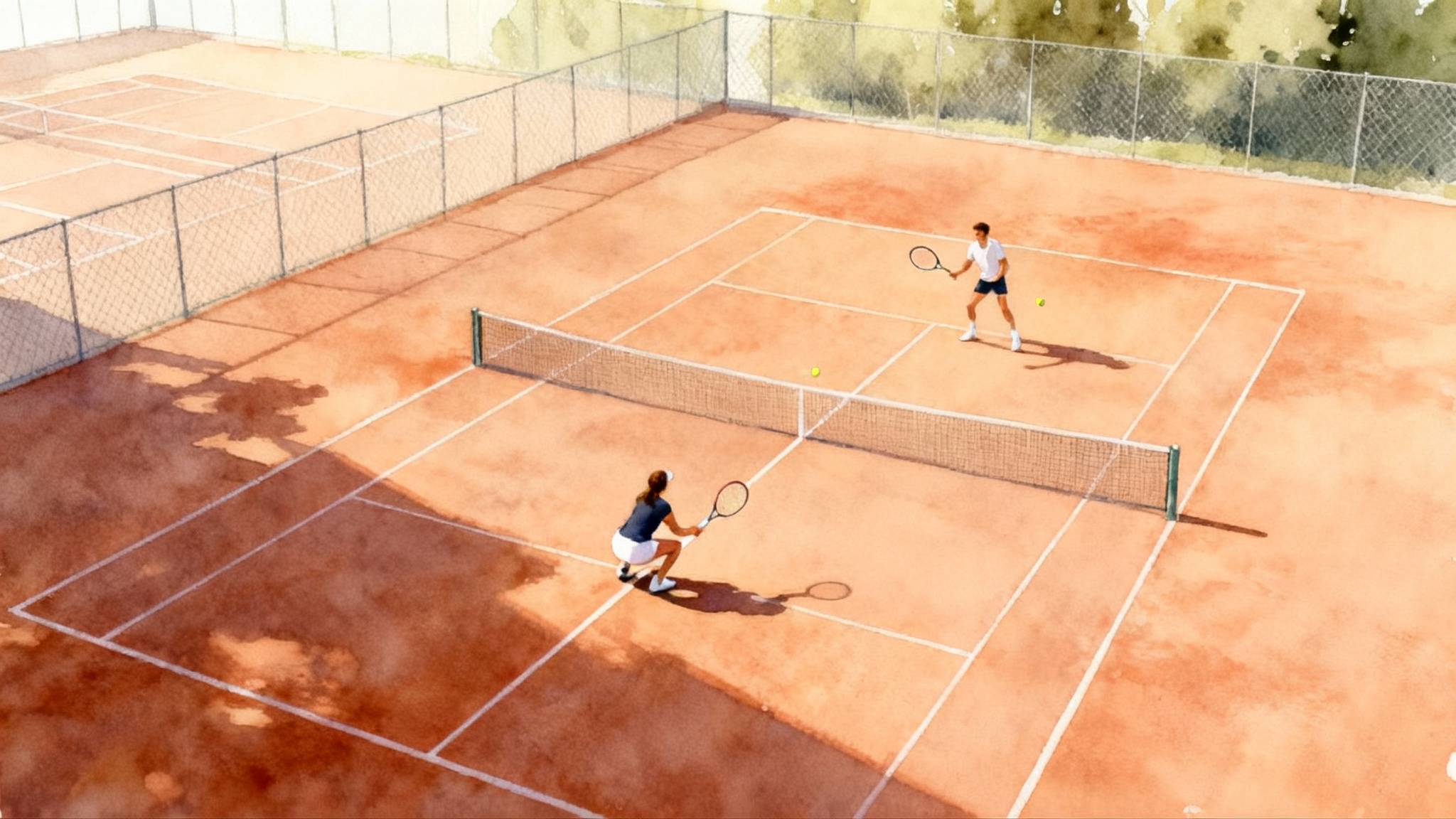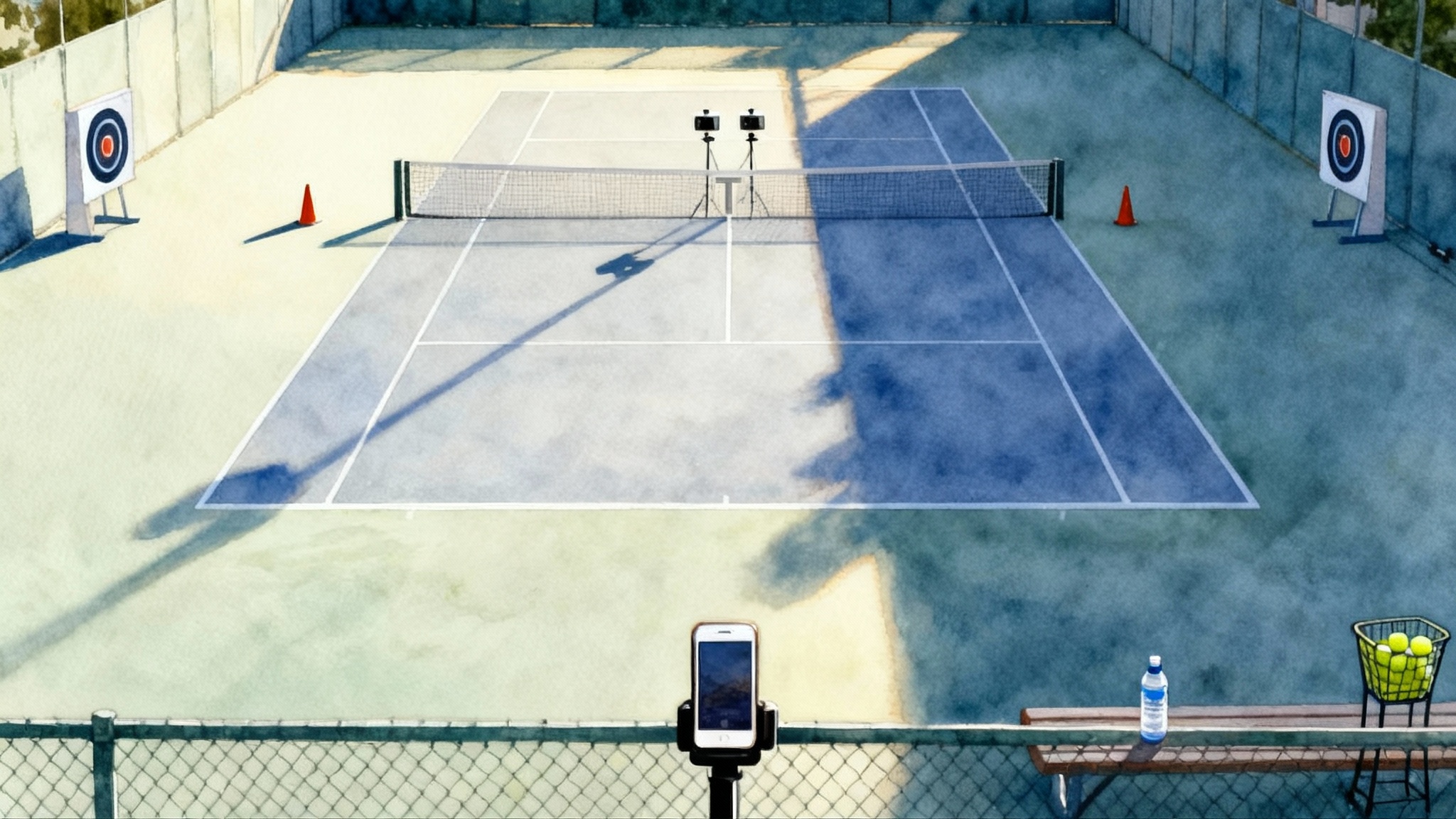College Tennis Recruiting 2025–26: Emails, Video, UTR Benchmarks
A practical parent and player guide for 2025–26 recruiting. Learn grade-by-grade steps, coach email templates, highlight video specs, UTR and GPA targets by division, visit checklists, scholarship realities, and a 30‑day outreach plan.
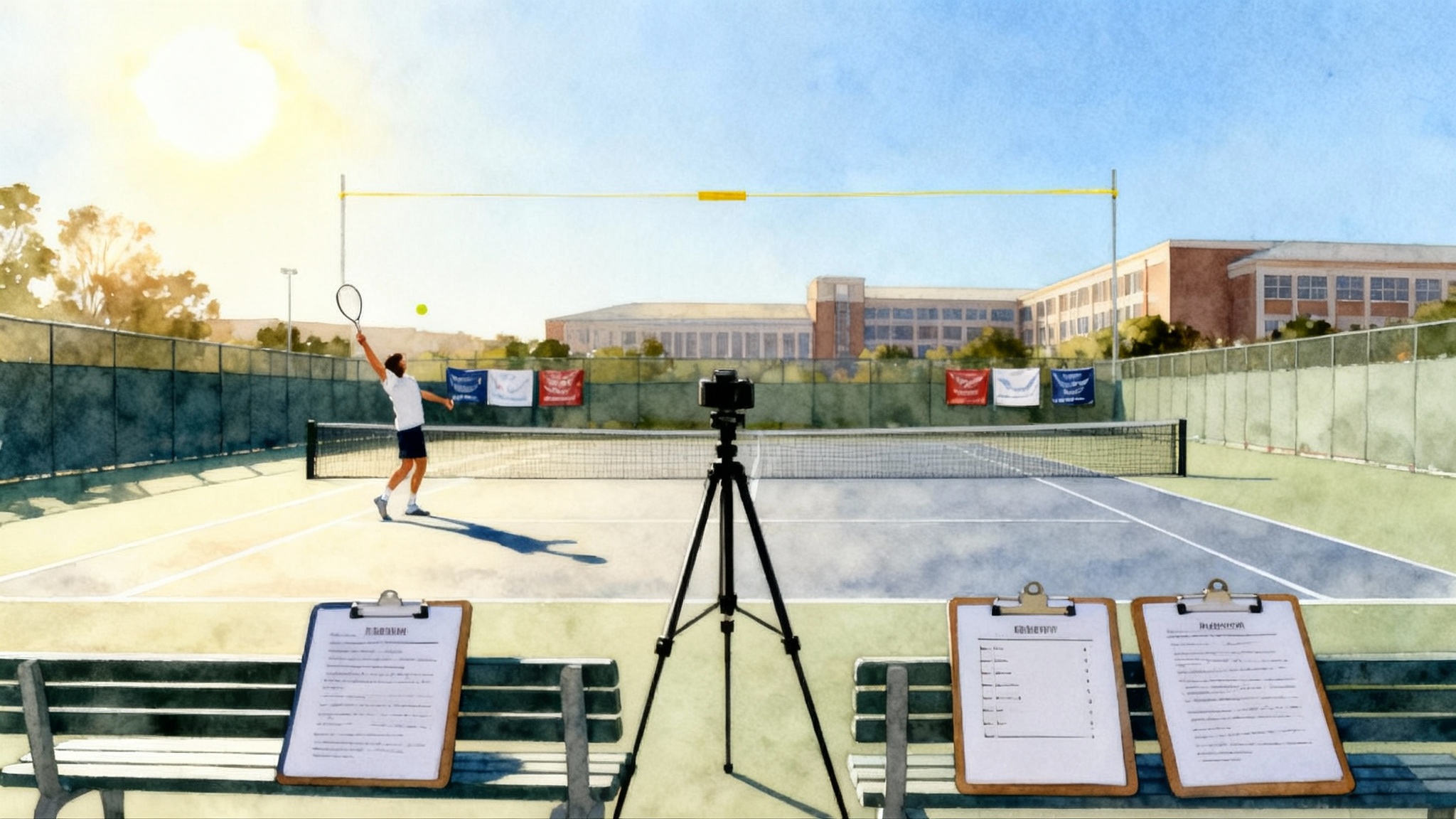
The 2025–26 recruiting reality in one page
If you remember only one thing, make it this: execution wins. Players and parents who build a focused target list, communicate well, and show steady development get recruited. The rest is noise.
Two rating systems matter most. World Tennis Number is a global rating used by federations and events. If you are new to it, read the International Tennis Federation’s overview on how WTN works. Universal Tennis Rating is widely used by college coaches to compare players across regions and ages. Learn what drives your rating in UTR’s explainer, what UTR measures. You do not need to obsess over daily fluctuations. You do need to understand how coaches use these numbers as a quick filter before they watch video, read resumes, and track progress over time.
This guide gives you a grade‑by‑grade plan, ready‑to‑send emails, a highlight video shot list and filming specs, realistic UTR and GPA targets by division, visit checklists, scholarship realities, a 30 day outreach plan, and a printable one page tennis resume template.
Build a target list with UTR and WTN the smart way
Use ratings as a doorway, not a destiny. Coaches want competitors who improve, win the big points, and fit their team culture.
Follow this sequence:
-
Capture your current numbers. Write down current singles UTR and doubles UTR, and your WTN. Add win rate over the last 90 days and your best three wins.
-
Map your trajectory. Compare your UTR now to six months ago and twelve months ago. Coaches care about slope as much as the snapshot. A steady rise of 0.10 to 0.20 UTR per quarter is meaningful.
-
Study rosters. Google “School Name tennis roster UTR” and look at recent lineups. Note UTR of line 2, line 4, and line 6 from last season. This creates a realistic bandwidth for that program.
-
Fit yourself to the lineup. If your current UTR is within 0.2 of a program’s typical line 6, you are in the conversation. If you are within 0.5 of line 4 and your trend is rising, you are a development bet. If you are 0.8 or more below line 6, treat it as a reach unless your trajectory is steep and backed by strong video and results.
-
Use WTN as a cross check. If a coach or event relies more on WTN, compare your number to their current players. Consistency across both systems builds trust.
-
Build a three tier list. Ten target schools where your UTR is within 0.2 to 0.5 of line 4 to 6. Five reach schools where you are 0.5 to 0.8 below line 6 but rising. Five safety schools where you are at or above line 4.
Add columns for major, location, roster balance by class, international versus domestic mix, and the assistant coach who recruits your region. To choose events that move your rating and profile, use our planning guide on 2025–26 tennis calendars, UTR, USTA, ITF.
UTR and GPA benchmarks by division
These are typical roster ranges, not hard cutoffs. Programs vary and trends change. Use them to calibrate your list, then reach out and ask where the staff sees you.
Division I
- Men
- Top 25 programs: UTR 13.5 and higher
- Competitive majors and strong mid majors: UTR 12.0 to 13.5
- Developmental DI programs: UTR 10.8 to 12.2
- Women
- Top 25 programs: UTR 10.5 to 11.8 and higher
- Competitive majors and strong mid majors: UTR 9.5 to 10.8
- Developmental DI programs: UTR 8.2 to 9.8
- Academics
- GPA 3.5 and higher opens more options for merit aid and selective majors
- Standardized testing is often optional for admission, yet a solid score can unlock merit dollars. As a rule of thumb, a 1250 plus SAT or 28 plus ACT strengthens your academic profile. Check each school’s policy.
Division II
- Men: UTR 10.0 to 12.5 for impact roles, with top teams reaching higher
- Women: UTR 8.5 to 10.5 for impact roles
- Academics: GPA 3.3 and higher helps with stacking academic and athletic aid
Division III
- Men: Wide range from UTR 8.0 to 12.0. Top DIII can reach 11 plus
- Women: UTR 7.0 to 10.0. Top DIII can reach 9.5 plus
- Academics: Admission and merit drive the process. GPA 3.7 and higher is significant at selective schools. Strong course rigor matters
NAIA
- Men: UTR 9.0 to 11.5 across most competitive rosters
- Women: UTR 7.5 to 9.8 across most competitive rosters
- Academics: Merit scholarships stack readily. GPA 3.3 plus improves total package
NJCAA
- Men: UTR 7.0 to 11.0, with top junior colleges developing players who later transfer to DI
- Women: UTR 6.0 to 9.0, with similar transfer paths
- Academics: Keep transcripts clean for a smooth transfer into four year programs
Remember that many staffs weigh traits that numbers do not capture. Movement, point construction, serve quality, return depth, shot tolerance, tactical discipline, and competitive grit travel well across surfaces and schedules.
Grade by grade execution plan
Eighth grade
- Build the habits. Weekly fitness, footwork ladders, and a simple match journal
- Start a highlight clip reel with clean fundamentals. No music needed
- Create a short player bio and a Gmail address that looks professional
Ninth grade
- Track all matches in one sheet. Include opponent UTR, score, and a one sentence lesson
- Film two matches from the back fence. Save the raw files
- Set up profiles on UTR and WTN and keep them current
- Begin a light school list based on size, location, and majors
Tenth grade
- Update your video with live points and patterns. Add serve and return sequences
- Identify twenty schools. Follow both coaches on social media and take notes on their style and roster needs
- Introduce yourself with a short email and a three to five minute video link
- Take the most challenging classes you can manage. Keep grades high and improve study habits
Eleventh grade
- Play events that improve your schedule strength. Seek good matchups, not only easy wins
- Send two updates per semester to coaches with new wins, video, and academic notes
- Visit campuses unofficially if you can. Watch practice, meet players, and see facilities
- If testing helps your case, take the SAT or ACT early enough to retest if needed
Twelfth grade
- Sharpen your video and send a clean mid season update
- Ask directly about fit, timeline, and next steps. If a program is full, pivot quickly
- Keep training hard through graduation. Late spring and summer transfers can open a spot
Coach outreach that gets replies
Subject lines that get opened
- 2026 recruit, 10.6 UTR, lefty serve and volley, short video
- 2026 recruit, 3.8 GPA, rising 9.8 UTR, looking at environmental science
- Texas 2027 recruit, 10.2 UTR, 6 foot 2, recent wins vs 10.8 and 10.6
Initial email template
Hi Coach [Last Name],
I am [Full Name], class of [Year], from [City, State]. My current UTR is [Singles UTR] and [Doubles UTR]. I have a [GPA], and I am interested in [intended major].
In the last three months I have wins over [Player UTRs or names], and I am trending up [brief trajectory note]. Here is a 3 minute video that shows live points and patterns: [link].
I admire [specific aspect of the team or a recent result]. Based on your roster’s recent lineups, I believe I could compete for [role or lineup] and add value in [specific ways, for example doubles energy and return depth].
Could I get feedback on my fit and what you look for in a [position or class] for [entry year]?
Thank you for your time, Coach. I attached a one page resume with academics, results, and schedule.
Best,
[Name] | [Phone] | [Email] | [City, State]
Update email template
Subject: Spring update, 10.4 to 10.7 UTR, new 3 min video
Coach [Last Name],
Quick update since we last spoke. My singles UTR moved from 10.4 to 10.7 with wins over [opponent UTRs]. I tightened my return patterns and first serve percentage is up five points. New 3 minute video link: [link]. GPA is [GPA]. Upcoming schedule: [list two events]. Would you like to schedule a call this week?
Thanks for the feedback you shared on [earlier point]. I applied it in the last two events.
[Signature]
Tournament schedule email template
Subject: July schedule and quick video refresh
Coach [Last Name],
I will be in [City] for [event] on [dates]. If you attend, my matches are likely to start [morning or afternoon]. I attached my one page resume and a 2 minute clip that highlights serve patterns and first ball aggression.
Thank you,
[Signature]
Pro tips
- Keep emails to 150 to 200 words
- Make it skimmable with bolded numbers and short paragraphs
- Use a short, unlisted video link. Avoid giant attachments
- Always add one specific detail about the program so it does not read like a mass email
Highlight video that coaches actually watch
Length and structure
- Total runtime 3 to 5 minutes
- Open with 20 seconds of groundstroke rhythm from behind the baseline
- Show 8 to 10 live points from the back view. Keep the ball in frame the whole rally
- Include serve plus one pattern from both deuce and ad sides
- Add 6 return points that show depth and direction. No trick shots. For technique and decision making, see our return of serve mastery guide.
- End with two 10 point tiebreak snippets that show pressure moments
Shot list
- Forehands and backhands crosscourt and down the line, alternating
- Serves: flat, slice, and kick. Show pace and location variety
- Returns: deep middle, then change of direction
- Approaches and volleys, plus two overheads
- Transition points that demonstrate footwork and recovery
Filming specs
- Camera behind the baseline, on center line, at a height that clears the net tape
- 1080p at 60 frames per second. Lock exposure and focus
- Use a tripod or fence mount. Do not handhold
- Natural audio is fine. No music required
- Keep the sun behind the camera if possible
- Title the video “Name, class year, UTR, date, 3 minutes”
Editing and delivery
- No slow motion except for a single short segment if needed
- Keep on screen text minimal. Name, class year, UTR, and a contact line is enough
- Host as unlisted and share the link in your email signature
- Save raw files in a folder. Coaches may ask for full games
For a deeper walkthrough of camera setups, framing, and sample shot lists, use our smart‑court and phone video guide.
Unofficial and official visits checklists
Unofficial visit checklist
- Confirm whether coaches can meet in person under current rules. If not, plan a self guided campus walk and watch practice from public areas
- Prepare five questions about training blocks, player development, travel, and academics
- Ask to meet current players if permissible. Listen more than you talk
- Watch a practice drill block. Note tempo, feedback, and player to coach ratio
- Tour academic support and strength spaces. Picture your daily routine
- Take notes right after the visit while details are fresh
Official visit checklist
- Pack tennis gear for a possible hit. Bring a notebook and a copy of your resume
- Ask for a typical weekly schedule with lifts, study hall, and travel
- Clarify scholarship structure, academic support, and how injuries are handled
- Meet the athletic trainer and academic advisor if possible
- Sleep in the dorm or with a host if offered. Ask hosts what surprised them as freshmen
- Send a thank you email within 24 hours that includes one specific highlight from the visit
Scholarship realities in plain language
Men’s tennis funding is often spread across the roster. Expect partial awards and plan to stack academic and need based aid. Full rides happen, especially for early lineup players, but most packages combine athletics, academics, and sometimes leadership or departmental funds.
Women’s tennis funding tends to be deeper. More teams carry larger athletic aid pools, and full or near full packages are more common for lineup players. That said, academics still drive many of the best packages. A strong GPA can unlock merit dollars that are renewable and predictable.
Across all divisions, schools may fund below the maximum allowed. The head coach’s philosophy, the athletic department budget, roster size, and international recruiting strategy all shape offers. Be clear about total cost of attendance, what renewals require, and how increases are handled after year one.
Stacking strategy
- Keep GPA as high as possible to qualify for automatic merit tiers
- If testing helps, submit scores to reach the next merit band
- Ask directly about stacking policies. Some schools reduce athletic aid when merit increases, others stack freely
- Understand the four year picture, not just year one
A 30 day outreach plan you can start today
Week 1
- Day 1 to 2: Build a list of twenty programs using the target and reach method above
- Day 3: Draft your resume and assemble your best three minutes of video
- Day 4: Write your first email and personalize it for five programs
- Day 5: Send five emails, track them in a simple spreadsheet, and set reminders
- Day 6: Film a full match from the back view. Save raw footage
- Day 7: Review the match with your coach. Note three patterns to improve
Week 2
- Day 8: Personalize five more emails with one program specific detail
- Day 9: Lift or movement session, then film serve and return blocks
- Day 10: Edit a 30 second video refresh and update your link
- Day 11: Send a brief update to the first five coaches with the new clip
- Day 12: Research roster needs for your next five programs using notes from box scores and past lineups
- Day 13 to 14: Compete. Capture scores and opponent ratings on your sheet
Week 3
- Day 15: Email the next five programs. Ask one specific question about development
- Day 16: Call or text an assistant coach if their contact is listed. Be concise and polite
- Day 17: Record a short training clip showing a pattern you are improving
- Day 18: Share the clip with any coach who replied, along with two upcoming events
- Day 19: Build your campus visit notes template
- Day 20 to 21: Compete or train, then add two new wins and one lesson learned to your log
Week 4
- Day 22: Follow up with every coach who has not replied. Keep it friendly with one new result
- Day 23: Ask your references if they are comfortable answering coach calls. Confirm contact details
- Day 24: Refresh your resume with any new results or academic updates
- Day 25: Film a second match in case a coach requests full sets
- Day 26: Send five short check ins with links to full match files if asked
- Day 27: Audit your list. Move schools between reach, target, and safety based on replies
- Day 28 to 29: Train with intent on serve plus one and return depth
- Day 30: Reflect on the month. Keep what worked and trim what did not. Repeat the cycle
For planning future events and balancing schoolwork, see our calendar guide referenced above, and keep your files organized so updates are quick.
Printable one page tennis resume template
Copy, paste, and fill this in. Keep it to a single page in a clean font.
PLAYER INFO
Name:
Graduation Year:
Date of Birth:
Height and Weight:
Dominant Hand and Backhand:
City, State, Country:
Phone:
Email:
ACADEMICS
High School:
GPA (unweighted and weighted):
Class Rank or Percentile:
Course Rigor Highlights:
Test Scores (if submitting): SAT _____ ACT _____
Intended Major:
Academic Honors:
ATHLETICS
UTR Singles: UTR Doubles: WTN Singles: WTN Doubles:
Recent Trend: (for example +0.3 UTR last 6 months)
Style and Strengths: (for example aggressive baseliner, heavy forehand, strong return depth)
RESULTS SNAPSHOT
Top 5 wins in last 6 months with dates and opponent UTRs:
1)
2)
3)
4)
5)
Notable Events and Finishes:
VIDEO LINKS
3 minute highlight:
Full match 1:
Full match 2:
SCHEDULE
Upcoming tournaments and dates:
REFERENCES
Coach Name, Title, Phone, Email:
Coach Name, Title, Phone, Email:
Optional fast track package
If you want a short path from scattered files to a coach ready packet, our academy offers a filming and consult package. You get one on court filming session, a 3 to 4 minute highlight edit, a resume polish, and a personalized outreach roadmap.
Final word
You do not need to be perfect to be recruitable. You need steady improvement, clear communication, and the courage to ask for feedback. Use ratings to choose the right rooms, use video to show how you play, and use each month to raise your ceiling. The schools that match your game and your goals will see a competitor who gets better every season. That is the player every coach wants.
Related reading to accelerate your plan:
- Build a year and event plan with 2025–26 tennis calendars, UTR, USTA, ITF
- Film with confidence using our smart‑court and phone video guide
- Sharpen the receiving game with return of serve mastery
